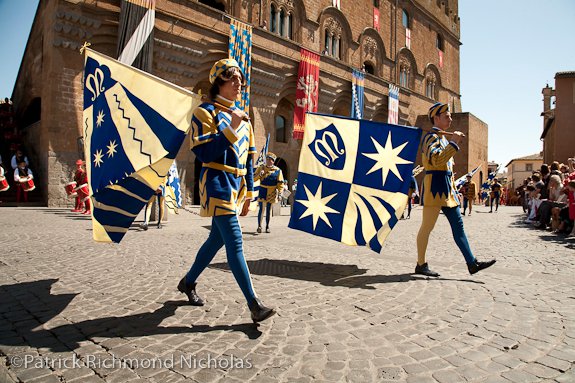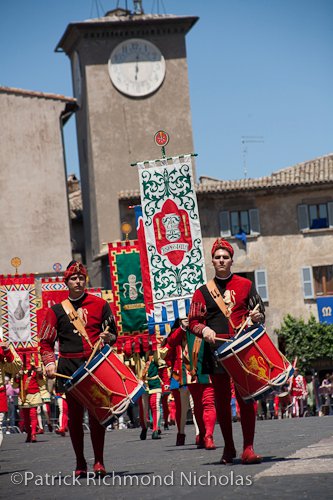The religious procession parades along with the Pageant, undoubtedly one of the most beautiful in Italy, which includes all the municipal courts of the time, coats and arms and weapons of the noble families of Orvieto offering a highly evocative and unforgettable experience having as background the incomparable scenery of the monuments and characteristic streets of Orvieto.

During the Pageant, people appreciate the majestic gait of characters, the rustle of shoes completely handmade in natural leather, the swaying of multi-coloured banners as stained-glass windows of cathedrals, the characteristic sound of the metal of the weapons, armours, helmets and the shields moulded, embossed and chiselled by hand by skilled gunsmiths and the preciousness of costumes whose minuteness of silver, gold and silk embroidery, makes them a real masterpiece.
A curiosity: why a procession of men only?
 When the cathedral was being built (the first stone was laid by Pope Nicholas IV in November 1290), Beltramo Monaldeschi, bishop of Orvieto, commissioned to Ugolino di Vieri da Siena the imposing Reliquary to protect the linen stained with the blood the Miracle of Bolsena.
When the cathedral was being built (the first stone was laid by Pope Nicholas IV in November 1290), Beltramo Monaldeschi, bishop of Orvieto, commissioned to Ugolino di Vieri da Siena the imposing Reliquary to protect the linen stained with the blood the Miracle of Bolsena.
The superb work was delivered on 1338, exactly 75 years after the miracle, and the people of Orvieto were so impressed by its beauty that modified the plan of the Cathedral to add a chapel to house the precious object.
They were so enthusiastic that they wanted to celebrate the arrival of the Reliquary with a solemn procession, to which the main town officials (Mayor, Justice Banner, Consuls, People’s Captain, representatives of the militia, nobles …) took part. They were all rigidly males.
If, as many believe, the Pageant is a commemorative re-enactment of the meeting between the Pope and the bishop coming from Bolsena, this fact wouldn’t explain either why a procession that winds through the town (the Pope’s meeting with the took place at the Bridge of Rio Chiaro, outside the town walls), or the reason why of a procession composed by men only (according to the chronicles of the period, not only the authorities accompanied the Pope, but a large crowd of men and women).
